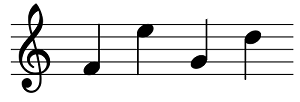
You can watch this lesson in the video below, or read at your ease under the video.

The whole note has a duration of 4 beats. In 4/4 time, this corresponds to a whole measure, from where ‘whole note’ has its name. The duration of a half tone is half of that of a whole tone, so 2 beats. And, logically, a quarter note has a duration of 1 beat.
Listen to a sound sample of the whole note, half note and 2 quarter notes as in the staff above. The metronome clicks every beat. You will hear the metronome count 4 beats before it starts.

An eighth note has a duration half of that of the quarter note, which means a half beat. You can thus have two eighth notes in one beat. The note symbol for an eighth note is:

A sixteenths note is again half as long as an eighth note. You can have 4 sixteenths notes in one beat.
The note symbol for a sixteenth note is:
When 2 or more eighths or sixteenths notes are played after each other, you can make beamed notes as follows:

Combinations are also possible:

Look at the next combination of quarter notes, eighth notes and sixteenths notes and listen to the corresponding sound sample. The metronome starts with 4 beats before it begins.


We can augment the note length by 50% by adding a dot after the note, for example:
Remark: a ¾ beat note followed by a sixteenth note (¼ beat) can be notated as beamed notes, as follows:

Example: look at the next combination of notes and listen to the corresponding sound sample. As always, the metronome starts with 4 beats before it begins.


Make sure to master your knowledge of note lengths by doing the exercises that are available via the 2 links below:
I would recommend a classical piano to learn our piano theory exercises. Check out best digital piano for classical pianists.
Please let us know what you think of this lesson by leaving a comment below.